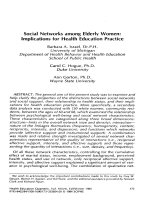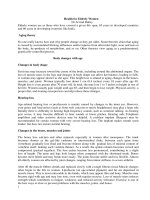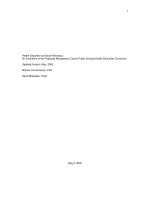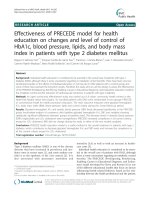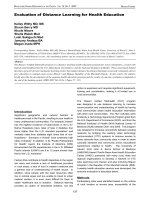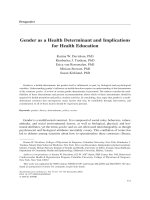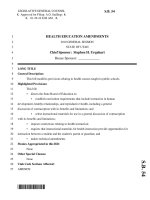Social Networks among Elderly Women: Implications for Health Education Practice pptx
Bạn đang xem bản rút gọn của tài liệu. Xem và tải ngay bản đầy đủ của tài liệu tại đây (1.3 MB, 31 trang )
173
Social
Networks
among
Elderly
Women:
Implications
for
Health
Education
Practice
Barbara
A.
Israel,
Dr.P.H.
University
of
Michigan
Department
of
Health
Behavior
and
Health
Education
School
of
Public
Health
Carol
C.
Hogue,
Ph.D.
Duke
University
Ann
Gorton,
Ph.D.
Wayne
State
University
ABSTRACT:
The
general
aim
of
the
present
study
was
to
examine
and
help
clarify
the
properties
of
the
distinctions
between
social
networks
and
social
support,
their
relationship
to
health
status,
and
their
impli-
cations
for
health
education
practice.
More
specifically,
a
secondary
data
analysis
was
conducted
with
130
white
women,
community
resi-
dents,
between
the
ages
of
60
and
68,
which
examined
the
relationship
between
psychological
well-being
and
social
network
characteristics.
These
characteristics
are
categorized
along
three
broad
dimensions:
structure—links
in
the
overall
network
(size
and
density);
interaction—
nature
of
the
linkages
themselves
(frequency,
homogeneity,
content,
reciprocity,
intensity,
and
dispersion);
and
functions
which
networks
provide
(affective
support
and
instrumental
support).
A
combination
was
made
and
relative
strength
investigated
of
several
network
char-
acteristics
representative
of
the
quality
of
interactions
(i. e.,
reciprocal
affective
support,
intensity,
and
affective
support)
and
those
repre-
senting
the
quantity
of
interactions
(i.e.,
size,
density,
and
frequency).
Of
all
these
network
characteristics,
controlling
for
the
cumulative
effect
of
marital
status,
income,
employment
background,
perceived
health
status,
and
use
of
network,
only
reciprocal
affective
support,
intensity,
and
affective
support
explained
a
significant
amount
of
vari-
ance
in
psychological
well-being.
The
combination
of
qualitative
net-
We
wish
to
acknowledge
the
important
contributions
made
to
this
study
by
Guy
W.
Steuart,
Berton
H.
Kaplan,
and
Bill
Ware,
and
the
editorial
assistance
provided
by
Noreen
Clark
and
Richard
Pipan.
174
work
characteristics
was
more
strongly
related
to
psychological
well-
being
than
the
effect
of
the
combined
quantitative
factors.
A
discussion
of
the
results
of
the
study,
limitations,
and
application
of
the
findings
to
health
education
is
included.
Particular
emphasis
is
given
to
the
role
of
the
health
educator
in
identifying
and
collaborating
with
social
networks
in
ways
which
recognize,
support,
and
strengthen
them
and
yet
do
not
undermine
these
natural
systems.
PSYCHOSOCIAL
DETERMINANTS
OF
WELL-BEING
During
the
past
twenty-five
years,
numerous
research
studies
conducted
in
several
fields
have
identified
various
psychosocial
factors
as
predictors
of
health
and
mental
health
status.
These
include:
(a)
stress,
(b)
social
support
and
social
networks,
(c)
competence,
(d)
socioeconomic
status
and
(e)
coping.’-&dquo;
For
example,
loss
of
a
spouse
(stress)
may
be
related
to
depression
for
one
individual
and
high
blood
pressure
for
another
person,
while
a
third
person
may
experience
no
significant
effects
on
his
or
her
well-being.
One
factor
that
has
gained
prominence
in
the
last
decade
as
having
a
potentially
direct
and/or
buffering
effect
on
physical
and
psychological
well-being
is
social
support.&dquo; 1-1-17
Although
the
cumulative
evidence
is
highly
suggestive
of
the
significance
of
social
support,
there
is
considerable
disagreement
and
confu-
sion
with
regard
to
definition,
role,
and
measurement
of
such
terms
as
social
support,
social
networks,
social
support
systems,
and
support
networks.
A
clarification
of
the
properties
and
dis-
tinctions
of
these
terms,
their
relationship
to
health
status,
and
their
implications
for
practice
is
needed.
This
was
the
general
aim
of
the
present
study,
which
focused
on
the
characteristics
of
social
networks
and
their
association
with
psychological
well-
being
among
a
sample
of
elderly
women
RESEARCH
PROBLEM:
SOCIAL
NETWORKS
AND
SOCIAL
SUPPORT-DIFFERENCES
AND
STUDY
EMPHASIS
Mitchell18
defines
a
social
network
&dquo;as
a
specific
set
linkages
among
a
defined
set
of
persons
with
the
additional
property
that
the
characteristics
of
these
linkages
as
a
whole
be
used
to
in-
terpret
the
social
behavior
of
the
person
involved&dquo;
(p.2).
In
ac-
cordance
with
this
definition,
for
the
purposes
of
this
study,
a
175
social
network
was
viewed
as
person-centered
and
comprised
of
numerous
characteristics
along
three
broad
dimensions: 18,19
(1)
structure-links
in
the
overall
network,
e.g.,
size
and
density;
(2)
interaction-the
nature
of
the
linkages
themselves,
e.g.,
fre-
quency
and
reciprocity;
and
(3)
functions
which
networks
pro-
vide,
e.g.,
affective
support,
tangible
aid,
and
services.
The
pur-
pose
of
this
research
was
to
examine
the
relationship
between
psychological
well-being
and
each
of
eleven
network
character-
istics.
A
social
network
then
refers
to
human
interactions,
some
or
all
of
which
may or
may
not
provide
social
support.
It
is
the
functions
which
networks
provide
that
establish
the
link
with
the
concept
of
social
support.
These
functional char-
acteristics,
as
described
in
the
literature, 15,111 22
are
defined
below:
1.
Affective
support:
the
provision
of
moral
support,
caring,
and
love
2.
Instrumental
support:
the
provision
of
tangible
aid
and
services,
e.g.,
loan
of
money,
food,
help
with
child
care
3.
Cognitive
support:
access
to
diverse
information,
new
knowledge,
advice
and
feedback
4.
Maintenance
of
social
identity:
validation
of
a
shared
world
view
5.
Social
outreach:
access
to
social
contacts
and
social
roles
These
characteristics
are
most
frequently
defined
in
terms
which
imply
that
their
presence
is
positively
related
to
health
status.
It
is
important
to
recognize
that
networks
which
do
not
provide
functions
and/or
provide
&dquo;negative&dquo;
ones
(e.g.,
dominance
rather
than
caring,
advice
when
it
is
not
wanted)
may
be
negatively
related
to
health
status.
Frequently
cited
definitions
of
social
support
are
quite
similar
to
the
functional
characteristics
of
social
networks.
Cobs13
refers
to
social
support
as
information
that
leads
people
to
believe
that
they
are
cared
for,
loved,
esteemed,
and
valued,
and
that
they
belong
to
a
network
of
communication
and
mutual
obligation.
Similarly,
Kahn
and
Antonucci23
define
social
support
as
inter-
personal
transactions
that
consist
of
at
least
one
of
three
char-
acteristics :
affect
(love,
respect),
affirmation
(acknowledgement
of
appropriateness
of
actions
or
statements),
and
aid
(money,
tangible
items,
information).
Building
on
these
definitions,
House&dquo;
defines
the
content
of
four
broad
classes
or
types
of
supportive
behavior
or
acts:
emotional
support
(affect,
esteem,
concern),
appraisal
support
(feedback,
affirmation),
informational
support
176
(suggestion,
advice,
information),
and
instrumental
support
(aid
in
labor,
money,
time).
Recently,
convincing
arguments
have
been
made
that
the
ex-
amination
of
social
networks
and
their
relationships
to
well-being
can
be
advantageous.2~-z9 The
major
points
of
these
arguments
which
were
most
applicable
to
the
decision
to
take
a
network
analytic
approach
in
this
study
are
stated
below:
1.
numerous
network
characteristics
could
be
examined
to
determine
their
relationship
to
psychological
well-being;
2.
the
context
(structure
and
interaction)
within
which
social
support
might
be
provided
could
be
investigated;
3.
the
quantity
and
quality
of
network
characteristics
and
their
association
with
psychological
well-being
could
be
examined
comparatively;
4.
the
results
of
the
examination
of
network
characteristics
might
provide
insights
for
resolving
the
conceptual
and
measurement
difficulties
regarding
the
concept
of
social
support;
and
5.
the
network
characteristics
important
for
interventions
aimed
at
enhancing
psychological
well-being
could
be
de-
lineated.
EXPLANATION
OF
VARIABLE
AND
PREVIOUS
RESEARCH
FINDINGS
Numerous
characteristics of
social
networks
are
discussed
in
the
literature.
As
stated
previously,
these
can
be
categorized
into
three
broad
areas:
structure,
interaction,
and
function.39,40
Structural
charcteristics
refer
to
the
links
in
the
network.
Those
examined
in
this
study
were:
size,
the
number
of
direct
contacts
of
the
individual,
and
density,
the
ratio
of
persons
who
could
know
another
one
(links
which
could
exist)
to
the
persons
who
actually
know
one
another
(links
do
exist).
Interactional
char-
acteristics
refer
to
the
nature
of
the
links
themselves.
Those
examined
in
this
study
were:
content,
the
meanings
that
persons
in
a
network
give
their
relationships
(e.g.,
neighbor,
friend,
co-
worker) ;
directedness,
the
reciprocity
in
a
relationship;
inten-
sity,
degree
of
intimacy
and
emotional
intensity
of
ties;
fre-
quency,
the
number
of
contacts
between
persons
within
a
network;
homogeneity,
the
extent
to
which
network
members
share
social
attributes
(e.g.,
age,
sex,
ethnicity,
and
social
class);
and
dispersion,
ease
with
which
network
members
can
make
177
face-to-face
contacts.
Functional
characteristics
address
the
func-
tions
that
networks
provide.
Those
included
in
this
study
were:
instrumental
support,
provision
of
tangible
aid
and
services,
and
affective
support,
provision
of
emotional
and
moral
support.
An
extensive
review
of
the
literature
regarding
these
social
network
characteristics
and
well-being
is
beyond
the
scope
of
this
paper.
Only
a
few
relevant
findings
will
be
presented
below.
For
additional
examples
and
more
depth,
the
reader
is
referred
to
the
following
reviews;
references
22,27,30-32.
Much
of
the
early
research
on
social
networks
was
exploratory
and
descriptive;
in
general,
it
was
found
that
high-density
net-
works
(&dquo;close-knit&dquo;)
strongly
influence
an
individual’s
conform-
ity
to
norms
shared
by
network
members
and
provide
more
instrumental
and
affective
support
in
both
everyday
and
crisis
situations
than
do
less
dense
networks.
This
provision
of
support
was
also
found
to
be
associated
with
larger
size,
less
dispersion
(closer
geographic
proximity),
greater
homogeneity,
and
reci-
procity
within
networks.3&dquo;39
Other
research has
specifically
examined
the
relationship
be-
tween
social
interaction
and
social
participation
(factors
similar
to
the
network
characteristics
of
size
and
frequency)
and
well-
being
among
the
elderly.
However,
these
investigations
have
not
been
within
the
broader
social
network
context
and
the
results
have
been
inconclusive. 40-41
Many
of
the
studies
that
have
used
a
network
analytic
approach
have
focused
on
the
structural
and
interactional
characteristics
of
networks
in
relation
to
health
status
and
have
also
had
varying
results.19.4J SD
As
a
response
to
these
studies,
several
authors
have
suggested
that
part
of
the
reason
empirical
findings
have
been
so
conflicting
is
that
it
is
not
the
quantity
(size
and
frequency)
of
social
interactions
which
is
associated
with
psychological
well-being
in
old
age,
but
rather
the
quality
(meaning,
intensity,
mutual
sharing),
and
they
call
for
further
examination
of
such
qualitative
factors.43,51-52
This
sug-
gestion
is
supported
theoretically
by
symbolic
interactionism
and
exchange
theory-,, 32,5-’,-60
and
also
empirically.
Study
results
stem-
ming
from
examination
of
the
association
between
the
qualita-
tive
interactional
characteristics
of
networks,
i.e.,
intensity
and
reciprocity,
and
well-being
include:
(a)
both
intensity
and
reci-
procity
are
positively
associated
with
mental
health
status;19
(b)
reciprocity
with
affective
support
is
predictive
of
depression
but
intensity
is
not6’
(c)
reciprocity
is
significantly
related
to
mental
health
status ; 41,49
(d)
presence
of
a
confidant
(similar
to
intensity)
is
positively
associated
with
psychological
well-being
in
an
el-
derly
general
population;62.63
and
(e)
in
an
elderly
population,
178
the
association
between
objective
or
quantitative
properties
of
social
networks
and
morale
is
mediated
by
a
person’s
subjective
or
qualitative
social
integration-including
the
network
charac-
teristic
of
intensity. 51
Social
network
research
which
has
investigated
the
relation-
ships
between
networks
and
health
status
has
primarily
focused
on
structural
and
interactional
characteristics.
The
social
support
literature
has
examined
factors
similar
to
functional
network
characteristics,
e.g.,
affective
and
instrumental
support.
Such
research
has
measured
the
presence
or
absence
of
support
in
general,
not
within
a
specific
network
context.
However,
the
numerous
findings
that
social
support
is
positively
related
to
health
status3.11.13.14.17.48.
64-~
do
suggest
the
value
of
investigating
the
functional
dimensions
of
social
networks.
Based
on
the
results
of
this
literature,
as
cited
above,
the
current
study
chose
to
examine
each
of
eleven
network
char-
acteristics,
as
categorized
according
to
structure,
interaction,
and
function,
and
their
relationship
to
psychological
well-being.
For
the
purpose
of
this
study,
psychological
well-being,
the
dependent
variable,
is
defined
in
accordance
with
Bradburn 67
in
terms
of
both
positive
and
negative
aspects
of
an
individual’s
situation.
Therefore,
not
only
do
negative
factors
such
as
anxiety
and
worry
influence
psychological
well-being,
but
positive
fac-
tors
such
as
self-esteem
and
feeling
loved
also
have
an
impact.
Several
personal
and
environmental
factors
which
were
con-
sidered
to
be
potential
predictors
of
network
characteristics
and/or
well-being
were
included
as
control
variables.
They
were:
use
of
network;
ability
to
accept
affective
support;
physical
health
status;
and
sociodemographic
factors.
HYPOTHESES
Based
upon
theory
and
research
as
discussed
above
and
the
conceptual
framework
developed
for
this
investigation,31
the
fol-
lowing
hypotheses
were
posited:
1.
Each
of
the
eleven
network
characteristics
separately
is
positively
associated
with
psychological
well-being,
e.g.,
size
density,
homogeneity,
affective
support.
(This
is
ac-
tually
eleven
separate
hypotheses.)
2.
Qualitative
network
characteristics
(i.e.,
reciprocal
affec-
tive
support,
intensity,
and
affective
support)
in
combi-
nation
are
expected
to
be
better
predictors
of
psycholog-
179
ical
well-being
than
quantitative
characteristics
(i.e.,
size,
density,
and
frequency
of
interactions)
in
combination.
~
METHODOLOGY
The
present
investigation
was
carried
out
using
data
collected
by
Hogue
and
Gorton.68
That
study
used
network
analysis
to
examine
the
interrelationships
between
stress,
social
support,
adjustment
to
retirement,
and
psychological
well-being,
among
a
sample
of
elderly
women.
Selection
of
Subjects
The
criteria
used
for
selecting
the
sample
were
that
the
re-
spondents
be
white
women
between
the
ages
of
sixty
and
sixty-
eight ;
approximately
half
had
to
be
retirees
who
had
stopped
work
two
months
to
five
years
before
the
interview
and
were
not
engaged
in
any
work
outside
the
home
during
the
last
ten
years.
Since
the
distinction
between
the
two
subsamples
was
not
of
primary
importance
in
this
study,
the
subjects
were
com-
bined
into
one
sample,
using
employment
background
as
a
con-
trol
variable.
Most
of
the
subjects
(72%)
were
obtained
from
a
Durham,
North
Carolina
1977
voter
registration
list.
Retirement
rosters
of
Duke
University
and
General
Telephone
and
Electric
Company
were
also
used
to
recruit
retirees
(18%).
The
remainder
of
the
study
population
(10%)
was
obtained
from
contacts
made
at
housing
units
for
the
elderly
and
a
subject
list
of
the
Center
for
the
Study
of
Aging
at
Duke.
Thus,
it
was
not
a
probability
sample.
One
hundred
and
thirty
women
were
studied;
seventy-five
re-
cent
retirees
and
fifty-five
not
recently
employed.
Data
Collection
Five
women
were
trained
in
interviewing
techniques
before
and
during
the
data
collection
period.
These
women
conducted
130
home
interviews
from
June
to
September
of
1979.
The
av-
erage
interview
length
was
two
hours,
with
a
range
of
from
fifty
minutes
to
almost
four hours.
The
interviewer
asked
the
respondent
questions
for
obtaining
names
of
network
members
involved
in
the
various
social
ex-
changes,
the
delineation
of
the
close
network,
and
the
identi-
fication
of
network
characteristics
and
obtained
sociodemo-
180
graphic
information.
The
respondent
completed
a
self-
administered
questionnaire
which
included
the
measures
of
psy-
chological
well-being,
ability
to
accept
affective
support,
and
physical
health
status.
Variables
in
the
Study
The
independent
variables
of
this
study
were
the
character-
istics
of
the
respondent’s
close
interpersonal
network.
The
close
network
consisted
of
up
to
five
individuals
the
respondent
felt
closest
to
and
most
able
to
confide
in
and
receive
moral
support
from.
(See
instrumentation
section
for
description
of
how
the
close
network
was
delineated.)
The
decision
to
examine
only
the
close
network
was
based
on
the
assumption
that
if
psycho-
logical
well-being
is
related
to
the
characteristics
of
any
network,
such
relationships
would
be
present
especially
in
the
close
net-
work.
The
operational
definition
of
each
of
the
network
char-
acteristics
examined
is
provided
in
Appendix
1.
The
dependent
variable
was
psychological
well-being,
which
was
operationally
defined
for
the
purposes
of
this
study
in
terms
of
psychological
states
(feelings)
rather
than
somatic
complaints
and
functional
status,
which
have
been
used
to
define
psycho-
logical
well-being
in
other
general
population
studies.69-73
Psy-
chological
well-being
was
further
defined
as
the
balance
be-
tween
positive
states
(e.g.,
feeling
proud,
interested,
on
top
of
the
world)
and
negative
states
(e.g.,
feeling
upset,
depressed
and
restless).
Therefore,
psychological
well-being
wa
considered
to
be
a
combination
of
both
positive
and
negative
feelings.
The
relationships
between
the
independent
and
dependent
variables
were
examined
with
control
for:
demographic
char-
acteristics
(income
level,
employment
background,
marital
sta-
tus) ;
physical
health
status;
and
use
of
network
members.
Ad-
ditionally,
ability
to
accept
affective
support
was
a
control
for
the
functional
characteristic
of
affective
support.
Use
of
network
was
defined
as
the
extent
to
which
an
indi-
vidual
talks
about
personal
matters
with
and
seriously
considers
the
advice
of
network
members.
Ability
to
accept
affective
sup-
port
was
defined
by
the
extent
to
which
an
individual
feels
com-
fortable
or
uncomfortable
when
members
of
their
network
show
warmth
or
friendliness,
listen
attentively,
and
show
approval.
Physical
health
status
was
defined
as
a
combination
(additive)
of
four
dimensions
of
perceived
health
status
(i.e.,
overall
health
at
present
time,
health
now
as
compared
to
five
years
ago,
health
181
troubles
interfering
with
activities,
and
health
compared
with
other
people
of
the
same
age).
Instrumentation:
Independent
Variables
In
order
to
obtain
information
about
the
social
networks
of
the
subjects,
Hogue 74
and
Gordon68,7s
applied
the
egocentric
net-
work
methodology
described
by
Fisher
and
his
colleagues.7’78
This
egocentric
network
analytic
method
elicits
networks
first
of
all
by
asking
the
respondent
to
give
names
of
persons
with
whom
he
or
she
shares
various
types
of
exchanges.
Examples
of
the
types
of
exchanges
in
which
the
subjects
of
this
study
were
asked
about
include:
who
helps
out
with
tasks
around
the
house;
with
whom
does
she
get
together
to
talk
about
hobbies
or
interests;
whom
does
she
talk
with
about
personal
matters;
whose
opin-
ions
does
she
consider
when
making
important
decisions;
who
takes
care
of
her
when
she
is
sick;
who
lends
her
money;
and
who
provides
transportation.
Questions
were
also
asked
to
iden-
tify
whom
the
subject
helped
as
well
as
who
helped
the
subject.
The
respondent
also
responded
about
the
meaning
she
applies
to
each
relationship,
the
distance
she
lives
form
each
network
member,
and
how
close
she
feels
to
each
network
member.
The
names
elicited
by
this
method
were
then
combined
into
one
list
of
the
full
network.
The
respondent
was
then
asked
to
name
anyone
else
who
is
important
to
her
that
did
not
show
up
on
the
list,
and
to
examine
the
full
network
list
and
select
up
to
five
people
in
descending
order
whom
&dquo;you
feel
very
close
to
now.&dquo;
The
names
elicited
made
up
the
respondent’s
close
net-
work.
Furthermore,
for
each
person
in
the
close
network,
in-
formation
was
obtained
for
the
remaining
network
characteris-
tics.
Instrumentation:
Dependent
Variable
Psychological
well-being
was
measured
by
the
Affect
Balance
Scale
(ABS),
developed
by
Bradburn
and
Caplovitz79
and
Brad-
burn.67
This
scale
measures
an
individual’s
position
on
two
in-
dependent
dimensions-positive
affect
and
negative
affect;
psy-
chological
well-being
is
the
extent
to
which
positive
feelings
outweigh
negative
feelings.
This
scale
was
considered
an
appro-
priate
measure
for
this
study
based
on
numerous
validity
and
reliability
tests
and
analyses67.71,8D,81
many
of
which
specifically
182
addressed
the
applicability
of
the
Affect
Balance
Scale
with
an
elderly
population.63,82.83
Instrumentation:
Control
Variables
A
series
of
questions
were
used
to
measure
the
control
vari-
ables-marital
status,
income
level,
use
of
network,
employment
background,
ability
to
accept
affective
support,
and
physical
health
status.
The
four
questions
asked
which
made
up
the
ability
to
accept
affective
support
dimension
were
drawn
from
the
study
of
Caplan
et
al.84
of
the
relationship
between
social
support
and
a
patient’s
adherence
to
medical
regimen.
The
Older
American
Resource
Survey
(OARS)
Overall
Physical
Health
Assessment
scale 115
was
used
to
measure
physical
health
status.
This
physical
health
assessment
scale
obtains
a
subjective
health
rating
of
an
indi-
vidual’s
perceived
health
status.
Data
Analysis
Basic
univariate
statistics
(range,
medians,
and
standard
de-
viations)
of
the
network
characteristic
variables,
control
vari-
ables,
and
psychological
well-being
were
examined.
Multiple
regression
analysis
were
carried
out
to
test
the
hypotheses.
For
each
hypothesis,
the
control
variables
(income,
marital
status,
employment
background,
use
of
network,
and
perceived
health
status)
were
first
entered
into
the
model,
followed
by
the
specific
network
characteristic
variable
being
tested.
Using
the
SAS
statistical
package,86
the
procedures
followed
to
test
if
a
given
network
characteristic
variable
had
a
significant
effect
in-
volved
first
examining
cumulatively
across
the
control
variables
the
Type
1
sum
of
squares,
mean
square,
and
resulting
F
statistic.
It
was
then
determined
whether
or
not
the
Type
1
sum
of
squares,
mean
square,
and
resulting
F
statistic
for
the
network
variable
explained
a
significant
amount
of
variance
in
affect
balance
above
and
beyond
the
cumulative
contribution
of
the
control
variables.
Since
this
was
the
approach
taken,
rather
than
an
examination
of
a
model
which
included
all
variables
together,
there
is
no
relevant
R2
statistic
to
report.
Also,
for
each
hypothesis,
the
in-
teractions
between
the
network
characteristic
variable
and
con-
trols
and
the
correlations
among
all
the
variables
were
examined.
To
identify
the
unique
contribution
made
by
each
individual
control
variable,
adjusting
for
all
the
other
controls,
a
multiple
regression
procedure
was
used
that
examined
the
Type
IV
sum
183
of
squares,
mean
square,
and
resulting
F
statistic.
In
this
study,
the
alpha
level
for
hypothesis
testing
was
set
at
.05.
RESULTS
Demographic
Characteristics
A
compilation
of
the
general
demographic
characteristics
of
the
study
population
is
as
follows.
The
mean
age
was
64.15
years;
68.5%
of
the
respondents
were
married,
and
22.3%
were
wid-
owed.
The
median
number
of
years
of
education
was
12,
with
13%
of
the
sample
having
had
more
than
16
years.
Occupational
status
was
obtained
for
the
subject’s
main
job,
and
39.8%
were
categorized
as
clerical,
25.2%
were
categorized
as
professionals
and
10.6%
as
managers.
The
income
of
32.3%
of
the
respondents
was
greater
than
$15,000.
Ninety-five
point
four
percent
of
the
respondents
were
Protestant.
Hypothesis
Testing
As
expected,
in
carrying
out
the
multiple
regression
analyses,
the
control
variables
(income,
marital
status,
employment
back-
ground,
use
of
network,
and
perceived
health
status)
cumula-
tively
did
account
for
a
significant
amount
of
the
variance
in
the
dependent
variable,
psychological
well-being.
Beyond
their
ef-
fect,
in
examining
separately
the
relationship
between
each
of
the
eleven
network
characteristics
and
psychological
well-being,
the
only
variables
that
made
an
additional
contribution
were
reciprocal
affective
support,
intensity,
and
affective
support.
As
indicated
in
Table
1,
affective
supportive
linkages
which
are
predominantly
reciprocal
do
explain
a
significant
amount
of
variance
in
psychological
well-being
above
and
beyond
the
con-
trol
variables,
F(1,103)
=
7.52,
p
<
.01.
Table
2
indicates
that
controlling
for
the
effects
of
other
variables,
the
intensity
(close-
ness)
of
relationships
within
a
network
does
explain
a
significant
amount
of
variance
in
the
dependent
variable,
F(1,107)
=
6.55,
p
<
.01.
As
presented
in
Table
3,
strong
affective
support
does
explain
the
variance
in
affect
balance,
above
and
beyond
the
control
variables,
F(1,103)
=
6.83,
p
<
.01.
In
combination,
these
same
three
variables,
which
were
de-
fined
as
qualitative
characteristics
of
networks,
were
found
(as
hypothesized)
to
be
a
better
predictor
of
psychological
well-
184
185
186
187
188

